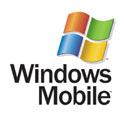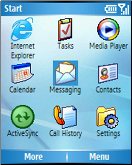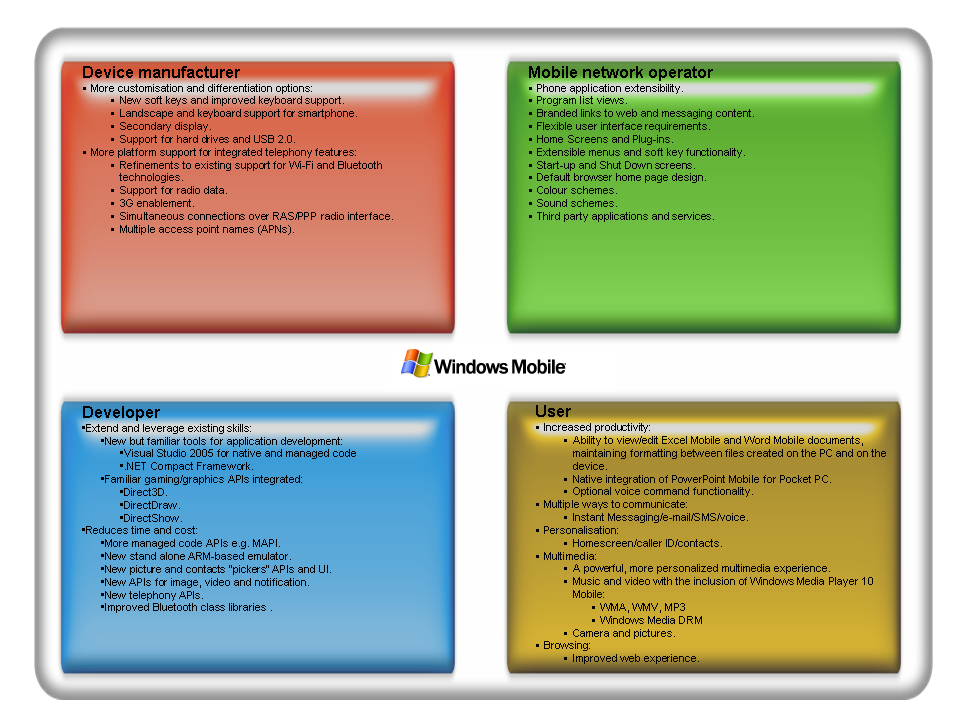 Keni Barwick has been blogging lots about Windows Mobile 5.0 (formerly codenamed Magneto) so now it’s my turn to chip in with my own view of why this update to the Windows mobile platform should not be ignored.
Keni Barwick has been blogging lots about Windows Mobile 5.0 (formerly codenamed Magneto) so now it’s my turn to chip in with my own view of why this update to the Windows mobile platform should not be ignored.
According to Microsoft (citing a December 2003 report from Gartner Dataquest) mobile device shipments are outstripping PC sales by a factor of 3:1 and quite simply, they want a piece of this market. The Windows CE platform has been with us now since 1996 and an IDC report (again cited by Microsoft) shows Pocket PC with a 57% share of the mobile device market in the first quarter of 2004. As momentum continues to grow Microsoft has recruited over 40 OEMs and 60 operators to back its Windows Mobile platform and on the mobile application front, Forrester have predicted that the mobile applications market will be worth $5.8bn to ISVs by 2006. Microsoft quote mobile operators reporting 25% average revenue per user (ARPU) increases with Windows mobile-based devices and are driving application growth through the Mobile2Market program.
Looking back at the history of Windows CE:
- 1996 – Handheld PC (codenamed Pegasus), Windows CE 1.0 (a cut down version of Windows 95), with monochrome display and 500,000 units sold.
- 1997 – Handheld PC (codenamed Mercury), Windows CE 2.0, colour (VGA) display, Microsoft Office applications.
- 2000 – Pocket PC 2000 (codenamed Rapier), Windows CE 3.0, simplified user interface.
- 2001 – Pocket PC 2002 (codenamed Merlin), Windows CE 3.0, new shell, Windows Media Player.
- 2002 – Pocket PC Phone Edition.
- 2002 – Windows Smartphone 2002 (codenamed Stinger).
- 2003 – Windows Mobile 2003 (codenamed Ozone), Windows CE 4.0 (re-branded as Windows Mobile), WiFi and Bluetooth connectivity, .NET Compact Framework, Windows Media Player 9.
- 2004 – Windows Mobile 2003 Second Edition.
Then, a few weeks ago at the Microsoft Mobile and Embedded Developer Conference, Bill Gates announced that Windows Mobile 5.0 had been released to manufacturing. According to Microsoft, Windows Mobile 5.0 is the best mobile enterprise platform for integration with Office, Exchange and for line of business application development, offering:
- New security and device management options.
- Improved integration with the Office System.
- Faster application development.
With Windows Mobile 5.0, Microsoft wants to extend the enterprise onto mobile devices and to help ISVs develop rich mobile applications, no longer just porting existing functionality to mobile devices, but taking advantage of mobile hardware to add functionality and value (e.g. using GPS, or a camera). Furthermore, the plethora of devices that are available means that there is no longer a single “killer device” and Windows Mobile 5.0 is about providing a platform, with OEMs applying the operating system to their own form factor.
As Marcus Perryman (a Developer Evangelist at Microsoft) highlighted in his recent presentation at the Microsoft Technical Roadshow, it is increasingly difficult to differentiate between personal digital assistants (PDAs) and smartphones. Typically, devices considered “phone first” employ single-handed operation, with battery life being key and hence using a slower processor; but some phones now incorporate WiFi capabilities. “PDA first” devices typically require two hands, and feature a stylus and touchscreen, although some now feature slide-out keyboards.
The screen shots below show the Windows Mobile 5.0 interface in smartphone and PDA formats, but the platform is the same.


The main difference is the addition of the soft keys at the bottom of the screen, in a manner which will be familiar to most mobile phone users, but now appear on PDAs too.
According to Microsoft, Windows Mobile 5.0 was designed to meet the following customer requirements:
- Device manufacturer:
- Differentiation and innovation.
- Platform development capabilities and ease of use.
- Mobile network operator:
- Differentiation with rich services and experiences.
- Drive ARPU, improve customer retention.
- IT professional:
- Security, reliability, manageability.
- Compatibility with current and future IT assets.
- Developer:
- Consistent platform.
- Familiar, productive tools.
- End user:
- Familiar user interface.
- Communications and services.
- Seamless multimedia experiences.
The graphic below shows some of the improvements which Windows Mobile 5.0 provides.

These new features in Windows Mobile 5.0 allow for partner innovation; whether that partner is a device maker, an operator or a developer and provide a host of improvements and new features for users.
Now I’m not a developer by any stretch of the imagination, but even I could appreciate how easy it is to code for mobile devices with the forthcoming Visual Studio 2005 (codenamed Whidbey) and the .NET Compact Framework. As Marcus Perryman demonstrated, using Windows Mobile 5.0 APIs, writing code for mobile devices has been greatly simplified, explaining that developers have a choice of writing web-based applications or smart client applications:
- Web-based applications use ASP.NET mobile controls served via mobile web pages to the mobile web browser (which support HTML 3.2 and WAP), allowing access to literally hundreds of devices; however they have a drawback in that they require a constant connection and are not full screen (due to the screen area used by the browser itself.
- Smart client applications are written for a particular device (or subset of devices), run their code locally and call .NET Compact Framework APIs. The .NET Compact Framework is a portable subset of the .NET Framework, with v2.0 offering 64% of the functionality in 8% of the size (1.5Mb), targeting mobile and embedded devices, offering C# and Visual Basic .NET compiler support and leveraging the capabilities of Visual Studio .NET to run managed .EXEs and .DLLs directly, offer debug support and to peacefully co-exist with the host operating system.
Developers also have access to new Windows Mobile 5.0 Pocket PC and smartphone emulator images which use a virtual machine to run the full Pocket PC/smartphone software independent of the host operating system, effectively bringing mobile device development to mainstream developer community.
All in all, Windows Mobile 5.0 looks like a huge step forward for Microsoft in mobile device support.
Links
Microsoft Mobile Developer Center
Microsoft Windows Mobile 5.0
Microsoft Windows Mobile 5.0 press release